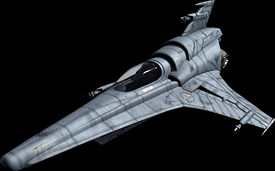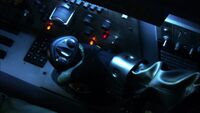- This article discusses the newer Viper-class fighters seen in the Re-imagined Series. For information on the older, generally obsolete Viper Mark II fighter from the same series, see Viper Mark II. For the Viper used in the Original Series and in Galactica 1980, see Viper (TOS).
| Viper Mk. VII | |||
|---|---|---|---|

| |||
| [show/hide spoilers] Spoilers hidden in infobox by default only. | |||
| Race: | Colonial | ||
| Type: | Military | ||
| FTL: | No | ||
| Propulsion: | 3 x turbothrust engines mounted aft, RCS points[1] | ||
| Crew: | 1 pilot in Terrell ES 24C ejection seat. [2] | ||
| Capacity: | |||
| CO: | {{{co}}} | ||
| XO: | {{{xo}}} | ||
| Role: | Space superiority fighter | ||
| Weapons: | 3 Kinetic Energy Weapons, missiles | ||
| Armaments: | 3 x forward-firing kinetic energy weapons (KEW), 2 mounted towards the outboard sections of the wings, 1 x mounted in the vertical stabiliser, Weapon hardpoints for mounting missiles / munitions pods, etc. under the wings.[2] | ||
| Defenses: | {{{def}}} | ||
| Aircraft: | {{{aircraft}}} | ||
| Aviation facilities: | {{{facilities}}} | ||
| Emblem: | [[Image:{{{patch}}}|175px|Ship's patch]] | ||
| Other Images: | Gallery | ||
| Dimensions | |||
| Length: | 9.8643 meters[3] | ||
| Width: | {{{width}}} | ||
| Height: | 2.9508 meters[4] | ||
| Weight: | {{{weight}}} | ||
| Wingspan: | 5.61 meters | ||
| Other: | {{{otherdi}}} | ||
| Cost: | {{{construction}}} | ||
| Construction Time: | {{{construction}}} | ||
| Hull Size: | {{{hull size}}} | ||
| Hull: | {{{hull}}} | ||
| FTL Cooldown: | {{{ftl cooldown}}} turns | ||
| Speed: | {{{speed}}} m/s | ||
| Turn Rate: | {{{turn rate}}}°/turn | ||
| Armor Total: | {{{armor total}}} | ||
| Armor Left: | {{{armor left}}} | ||
| Armor Right: | {{{armor right}}} | ||
| Armor Front: | {{{armor front}}} | ||
| Armor Rear: | {{{armor rear}}} | ||
| Armor Top: | {{{armor top}}} | ||
| Armor Bottom: | {{{armor bottom}}} | ||
| DRADIS Range: | {{{dradis range}}} m | ||
| Processing Power: | {{{processing power}}} | ||
| Munition Slots: | {{{munitions}}} | ||
| Munition Cooldown Period: | {{{munition cooldown}}} turns | ||
| Squadron Slots: | {{{squadrons}}} | ||
| Squadron Size: | {{{squadron size}}} | ||
| Special Abilities: | {{{special abilities}}} | ||
| Additional Information | |||
The Viper Mark VII was the Colonial Fleet's latest update to the venerable Viper Mark II primary space superiority fighter / attack craft. Capable of atmospheric flight, the Viper is a single-seat craft mounting two kinetic energy weapons (KEWs), as well as having hardpoints beneath the wings for mounting missiles, munitions pods and other ordnance (The Hand of God).
The Mark VII was the front-line variant of the Viper design, retaining the Mark II's general layout but adding fully integrated avionics that provide superior battle management and fight information for the pilot.
Ironically, it was the incorporation of the new integrated systems that prevented the majority of Mark VIIs from being effective during the Cylon attack: as with the majority of Colonial Fleet, the Mark VIIs suffer fatal computer system failures on contact with Cylon forces. Thanks to a Cylon agent's relationship with Dr. Gaius Baltar, scientist and programmer of the navigation software project, the navigational software in use onboard the majority of Colonial Fleet vessels contained backdoors that allow the Cylons to infiltrate a vessel's network by wireless signals and disable its power systems. While the problem could be overcome by removing the navigational upgrade compromised by the Cylons, this information is not discovered in time to be of major benefit to the surprised and hard-pressed Colonial forces.
Technical Specifications[edit]
Avionics[edit]

The Mark VII cockpit is almost totally computerized. There are far fewer analog gauges and more reliance on a more powerful central flight computer. This gives the Mark VII pilot far greater control of the fighter as well as, presumably, greater targeting control in a dogfight.
However, the latest and last software upgrade, the CNP upgrade, introduced a fatal flaw (inserted by a Cylon agent) in the Mark VII that led to the virtual annihilation of most of these fighters in the opening wave of the Cylon attack.
The surviving Mark VII fighters on both Galactica and Pegasus were likely retrofitted to older avionics packages to replace the compromised CNP, or other subsystems in the fighter were augmented or removed to minimize or eliminate further infiltration.
Performance[edit]
- While the Mark II could rotate 180 degrees vertically in .35 seconds (Act of Contrition), it is presumed that the Mark VII has an equal or better performance ratio.
Notes[edit]
- Since Galactica only had 40 Viper Mark IIs aboard as part of its museum, they needed as many fighters as possible. The remaining Mark VII's advanced computer systems were refitted to resist Cylon infiltration. However, since this is not how the Mark VII was designed to fly, the craft is increasingly more difficult to handle and can only be flown by the most experienced pilots such as Apollo and Starbuck. Galactica has roughly 6-8 Mark VIIs on board after the Cylon attack (Scattered, Flight of the Phoenix). (Source: Scifi.com series website)
- The stern section of a Viper is distinctive because of the offset "intakes" mounted just behind the cockpit. The port / starboard "intake" nacelles incorporate small but powerful reverse thrust engines that can quickly counter a Viper's forward momentum in an emergency (The Hand of God).
- According to David Weddle during the Scar podcast the Mark VII cockpit design "was actually laid out based on, I think it's either the F-16 or the F-18." The side-mounted control stick more closely resembles that of the F-16, which is appropriate given the "Viper" nickname of the jet (that was initially the General Dynamics codename for the project).
- Like the Original Series' Viper, the weapons fire of Vipers on the Re-Imagines Series is red.
References[edit]
- ↑ Angular exhaust nozzle design suggest possible thrust-vectoring.
- ↑ Jump up to: 2.0 2.1 Ammunition used was same as older Viper models; the Mark VII guns appear to have a higher rate of fire. Armaments listings and ejector seat details from David Bassom's Battlestar Galactica: The Official Companion.
- ↑ Dimensions provided by Lee Stringer, one of the VFX Animators of the miniseries. These are for the CGI models, which are based on but not identical to the fullsize props. Source: Starshipbuilder.com forums
- ↑ In flight, without landing gear. Landing gear adds approximately 0.5m.
